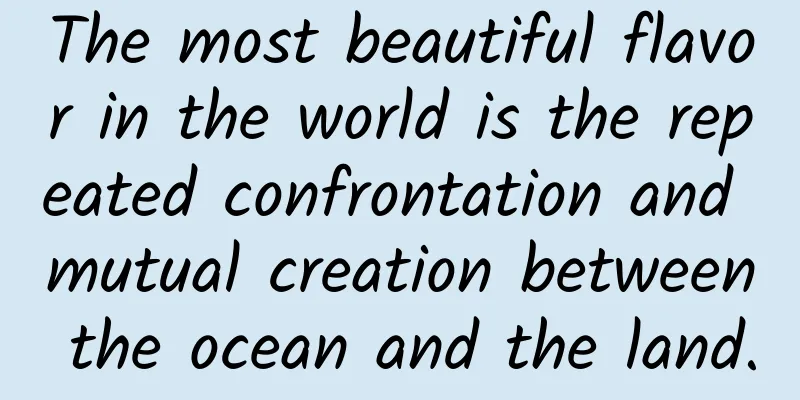The most beautiful flavor in the world is the repeated confrontation and mutual creation between the ocean and the land.

|
Written by Wei Shuihua Header Image | A Flavour of the World 3: Fresh Sea Food "Flavorful Origins 3: Fresh Sea Food" has come to an end. Not surprisingly, it once again topped the Tencent Documentary-Food Category list. This season of "Flavorful Origins", which is themed on seafood, starts from the ingredients and tastes themselves. Compared with the first and second seasons of "Flavorful Origins", which cover a wider range, it can be said to be a different approach. In today's highly involuted food documentary, delicious food, cool shots, and brilliant writing have largely become the standard of major IPs, not exclusive to "Flavorful Origins 3". But what makes "Flavorful Origins 3" stand out and become the opening dinner of 2022? Yes, in addition to "eating and talking about food", "Flavorful Origins 3" hides more flavor cores. No.1 Wu Quansheng runs a dry goods workshop at Baimajing Fishing Port in Danzhou, Hainan. Every winter, when red fish is on the market, he buys fresh red fish and pickles them to make dried red fish. Like most dried seafood, the production of dried red fish requires a combination of rough and delicate skills: chopping with a sharp axe, beating with a sharp knife, salting with heavy salt, washing with clean water, and slowly drying in the sun. Because of his excellent knife skills, Wu Quansheng is known as "Wu Sandao" in the underworld. The homely red fish clay pot rice, the popular fried red fish, and the popular red fish steamed meat pie all come from the distant ocean and the creative fishermen. Ayun, who lives in Shajiang Village, Ningde, Fujian, returned to his hometown after graduation to follow in his father's footsteps and grow kelp. Only four years after taking over, he has not yet mastered the "core technology" of preparing kelp - planting it at sea and hanging it to dry after five months. It seems ordinary and simple, but it requires inhumane experience. As one of the most popular seafoods in China, kelp has a wide range of applications, from mountains and hills to water towns and coastal fishing villages. In almost all regions, kelp seems to have a place in cooking. But in the final analysis, it is still a gift from the ocean and a product of the labor of fishermen. Ayun, who inherited his father's business, raised two children who grew up by the sea and cultivated their taste buds with kelp. In this country where farming is the origin of civilization, land with soft water and clear wind that is suitable for farming has always been a symbol of civilization, education, and livability. Farming and reading are passed down from generation to generation, cultivating clouds and sowing rain, intensive farming, and enjoying farming... Almost all idioms with the word "farming" have clear scene characteristics and strong positive connotations. On the contrary, when it comes to mountain people and sea people, it is simply summarized as "living off the mountain and living off the sea." In people's subconscious, the sea has always been marked by frontiers, ignorance, desolation, and roughness. This is a prejudice from history, and it is also a manifestation of the fact that China's marine culture has long been neglected. But in fact, China has a coastline of 32,000 kilometers and tens of millions of sea dwellers who depend on the ocean for their livelihood. The ocean provides them with food for their survival and also gives them a unique worldview and way of dealing with things. Mr. Qian Mu said that China is not a single agricultural country, but a combination of agricultural and nomadic fishing and hunting civilizations. But what many people don’t know is that not only the mainland has agricultural and nomadic fishing and hunting cultural forms, but the ocean also has them. In the ocean, people can grow kelp and laver, raise small seafood, and go out to sea to hunt fresh seafood. These different livelihoods have shaped another form of civilization that is unique and naturally grown, and has the same goal as the mainland civilization. From Wu Quansheng to Ayun, to Lin Benben, a child from Pingtan, Fujian who dreams of becoming a geographer, to Mu Liping, a female master who quit her job to run a fishery in Yanbian, Jilin, these strange and familiar faces that appear in "Flavorful Origins 3" actually represent an important settlement of the Chinese people: the sea people. "Flavorful Origins 3" may have put the diet of the Chinese sea people under the spotlight for the first time, and it may have set a precedent for the Chinese documentary industry to pay attention to local marine civilization. No.2 How did the ancient Chinese view seafood? The literati's notes "Records of Strange Things in Fujian" ranked aquatic products as "one lake, two rivers, three streams, four seas, and five ponds": Obviously, lake crabs, Yangtze River crabs, and Yellow River carp were the politically correct ones on the tables of the ancient Chinese. Seafood is only slightly better than the products from small, stagnant ponds. I'm afraid this is the lowest evaluation among countries with coastlines in the world. The Palace Museum still preserves the "Illustrated Map of Sea Creatures" from the Kangxi period. As an atlas of royal creatures, it represents people's considerable understanding of seafood at that time. However, according to today's scientific standards, this atlas can only be regarded as a cartoon at best. Li Yu's "Random Notes on Leisurely Feelings: Food and Beverages" from the same period included "miscellaneous aquatic creatures" after fish, shrimp, turtles and crabs. It was not until the 18th century, when Suiyuan Food List was written, that Yuan Mei listed seafood in a separate chapter. But at the beginning, Yuan said reluctantly: "There is no seafood in the ancient eight delicacies. Nowadays, the world is popular, so I have to follow the crowd." What Yuan Mei called "worldly" refers to the coastal areas of Zhejiang and Fujian where he traveled and lived throughout his life - also one of the most active areas of China's maritime culture. The view that a certain civilization is considered vulgar comes from the cognition of the literati who controlled the discourse power in ancient China, and also from the prejudice of the inland farming culture against the ocean. But in "Flavorful Origins 3", we can see all kinds of seafood that we have never heard of: the stone crabs in Liaodong Bay, which are called "red-shelled red" by the people because of the red abdomen and the edges of the claws. They are tender and tender when pickled raw, and plump and delicious when steamed. Compared with other sea crabs, they are sweeter, which is the taste effect of glycine in crab meat. The crabs in Hangzhou Bay, also known as the crabs of the hand and the crabs of the crab, are only the size of a thumb and seem to have no meat to eat. However, fishermen in eastern Zhejiang like to pickle these crabs with salt and Huadiao wine. Because of their small size, they only need a short cooking time to obtain amazing freshness, and are a great accompaniment to rice. The scientific name of the small blue dragon should be "wave lobster". It spends its infancy in shallow waters and lives in deeper waters when it grows up. Today, the Tanka people, who have changed their traditional fishing and hunting to farming, catch and raise the wave lobsters when they are young. When the shrimp meat is plump, it can be used to simmer coconut chicken, tofu soup, or blanched and eaten directly. The seafood that appears in "Flavorful Origins 3" is familiar or unheard of in traditional culture, which ignites the audience's curiosity and also fills in the unfamiliar page of the Chinese cuisine with a complete modern knowledge system composed of biology, chemistry and geography. To some extent, the birth of "Flavorful Origins 3", which focuses on the topic of the ocean, in today's special era is not accidental but inevitable. It highlights the iteration of Chinese people's ideas of examining the ocean and discovering the world. It also implies that this rising nation is reshaping the style of a great power that is outward-looking, inclusive, seeking common ground while reserving differences, and living in harmony with diversity. No.3 The most noteworthy part is the various seafood cooking methods in "Flavorful Origins 3". Red fish from Danzhou, Hainan, is good to be steamed directly, but the dried red fish after being pickled and dried is full of another kind of sweet and warm fragrance. This is similar to the sun-dried mackerel made by Qingdao people. The film calls this process of slowly breaking down proteins and producing amino acids by salt, sunlight and wind "another form of cooking". It breaks the traditional concept that seafood is only fresh, and instead describes the true face of seafood in the eyes of Chinese sea dwellers through their food processing methods adapted to local conditions and their eclectic food storage techniques. This is a realistic restoration of the lives of Chinese sea dwellers, and also a breaking down and re-analysis of Chinese marine culture. In contrast, the pufferfish is another more extreme example: this marine fish, whose scientific name is the green-finned pufferfish, was once a slow-selling commodity in coastal areas because of its large head and small body and low edible value. However, with the advancement of cold chain technology, a large number of pufferfish were beheaded, skinned, frozen into hard lumps, and transported to the Sichuan Basin, far from the ocean. With the blessing of large amounts of oil, rapid fire, and various spices, the fishy smell is gone, and the advantages of the fish meat being delicate, firm, boneless, and not falling apart after long cooking are magnified. Whether it is hot pot, dry pot, pickled pepper, young ginger, or boiled, the pufferfish presents an authentic Sichuan cuisine style. Because the fish with its head cut and skin peeled looks like a mouse with a pointed mouth, the people of Sichuan and Chongqing gave it a very down-to-earth name: "Haoer Fish". From the content to the name, the localization of this food has been completely completed. The Haoer Fish, which has traveled through mountains and rivers, is a microcosm of technological progress, and an example of the expansion of cultural boundaries and the increasing proximity of marine civilization and land. There are many similar examples in “Flavorful Origins 3”, such as wrapping kelp with shrimp paste and cutting it into beautiful shrimp paste kelp rolls after cooking; tender yellow croaker meat is wrapped in tofu skin and fried in deep fry until golden brown; delicious sea intestines are cooked and served cold with toon... These seafoods are more or less combined with the most iconic ingredients of agricultural civilization, such as plant sprouts, soy products, pork and freshwater aquatic products, creating a dining table beauty with a mixture of sea and land and rich flavors. The intention of describing these exquisite dishes in "Flavorful Origins 3" is obvious: from the perspective of the dining table, they prove that agricultural civilization and maritime civilization are not irreconcilable. In today's anthropological context, the two can even become engines for mutual promotion and achievement. As Mr. Xu Zhuoyun said, the Chinese have never missed the Age of Exploration. Our seafarers once bravely colonized the South China Sea and made a living all over the world. Among those who influence today's global situation, the Chinese are a force that cannot be ignored. The "bow-shaped cultural belt" formed by China's curved coastline is an important part of Chinese civilization. -END- “Man and fate are interdependent, just like the ocean and the earth. They fight again and again, and they create each other.” This is the ending of “Flavorful Origins 3”, and it is also the most touching sentence. When the spring breeze returns and when Chinese people sit around the table to enjoy family reunion after the harvest, the New Year's dishes consisting of fresh vegetables, livestock, waterfowl, river fish and seafood prove the eclectic and inclusive nature of Chinese cuisine, and also prove that the ocean and land together constitute the ultimate anthropological proposition of Chinese civilization. |
<<: Are you laughing at Erha? He has been to the Olympics!
>>: His life goal is to obey the needs of the country, but why did he refuse promotion twice?
Recommend
How many of these “cute” mangrove plant names have you heard of?
Produced by: Science Popularization China Author:...
The cost of information flow promotion decreased by 54%, but the conversion rate increased by 200%. How was it done?
In the process of information flow advertising , ...
The second Lop Nur? Qinghai Lake, with its rich "green heritage", refuses!
Qinghai Lake is called a lake, but it looks more ...
5 major trends in brand marketing in 2021
Among the top ten popular slogans, Yuanfudao (A t...
Super dry goods | How to successfully hold a press conference without any basic knowledge!
Planning to executing a press conference is a very...
Fake orders are actually an illegal business model (with full text)
Brushing orders is actually an illegal business m...
Motorola Reflection: Ruined by Cultural Change
Ted C. Fishman, editor of Chicago Magazine, recen...
The secret to increasing fans and realizing monetization through refined operations!
Although traffic and fans are very important, wit...
Can "rice" cure sprained ankles? Don't disbelieve it, it's true!
Author: Zhou Mouwang, Chief Physician, Peking Uni...
How to write a new media marketing promotion plan?
What role does new media marketing play? How to s...
Wonders of the universe: Does the gold on Earth come from the crazy neutron star "alchemy"?
There is a fable called "Sun Mountain"....
High-end mobile phones have collectively "reached their peak". What is the regret of vivo, which has released 5 flagship models in 5 months?
Perhaps due to the "crazy" price-perfor...
Wang Tianqing: Analysis of Madai Financial Management Big Data Platform and Financial Risk Control Practice Cases
At the WOT "Internet +" era big data te...
The mystery of dark energy: Is the force behind the universe's expansion variable?
Author: Duan Yuechu and Huang Xianghong There are...
Advertising: 8 creative writing tips to increase your click-through rate!
We all know that the role of creativity is to att...









